Direct thermochemical liquefaction
The term direct thermochemical liquefaction (DTL) covers two main technologies: solvent liquefaction and pyrolysis. Both can use a range of resources such as biomass feedstocks and biomass-based residues and wastes. The products of these processes are bio-crudes (from solvent liquefaction) or bio-oils (from pyrolysis).
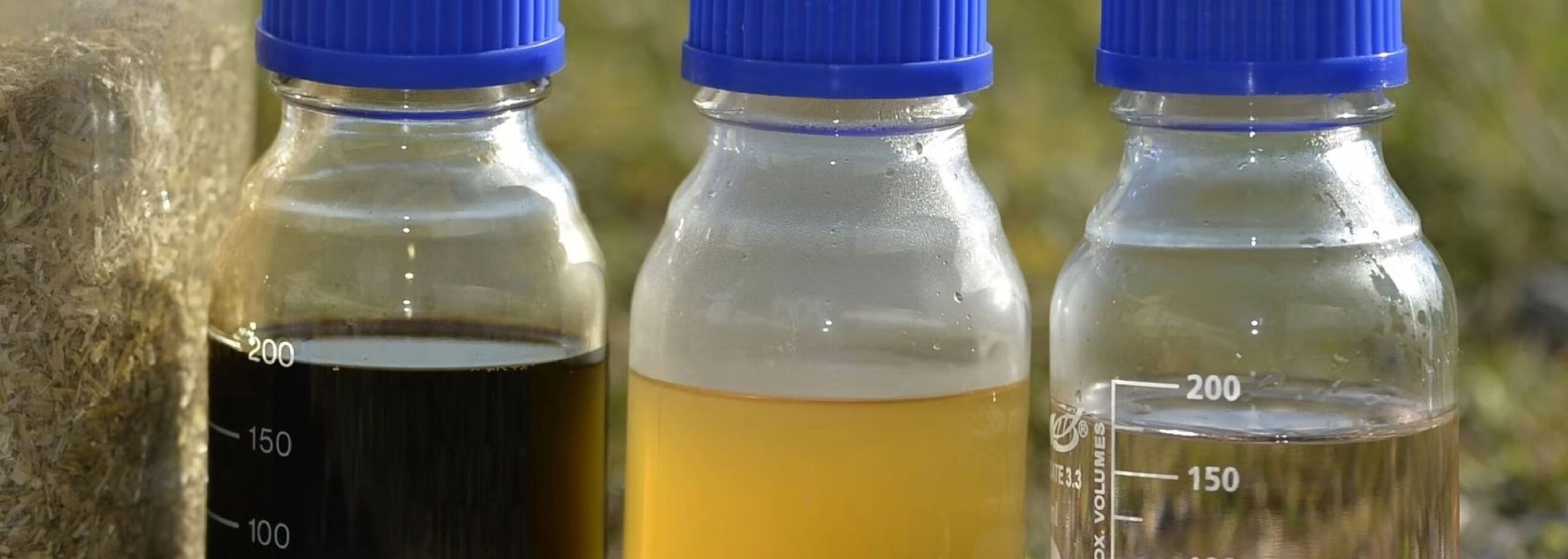
Bio-oil from fast pyrolysis is a sustainable alternative to fossil oil. It is used as boiler fuel today, but can also be upgraded to transportation fuels or chemical (Photo credits: Bioenergy TCP)
Both bio-oil and bio-crude are energy-dense liquids, obtained from biomass, that are easier to transport and handle. Fast pyrolysis bio-oil is used commercially for heat production in boilers today. Moreover, through further processing steps, bio-oil and bio-crude can be upgraded for use as low carbon intensity biofuels for transportation, and also as chemicals and other valuable products.
Solvent liquefaction is the thermochemical conversion of biomass at an elevated temperature in the presence of a pressurised solvent. The process leads to a biomass slurry which is called bio-crude. The underlying mechanism is the conversion of polymers in the solid biomass into primarily liquid components. This is why solvent liquefaction could essentially be described as the pyrolysis of biomass in a liquid solvent environment.
A distinction is made between hydrothermal liquefaction and solvothermal liquefaction. This difference is based on the solvents used. Hence, hydrothermal liquefaction uses water, and solvothermal liquefaction uses a range of different solvents. Various catalytic methods are used in combination with both liquefaction processes.
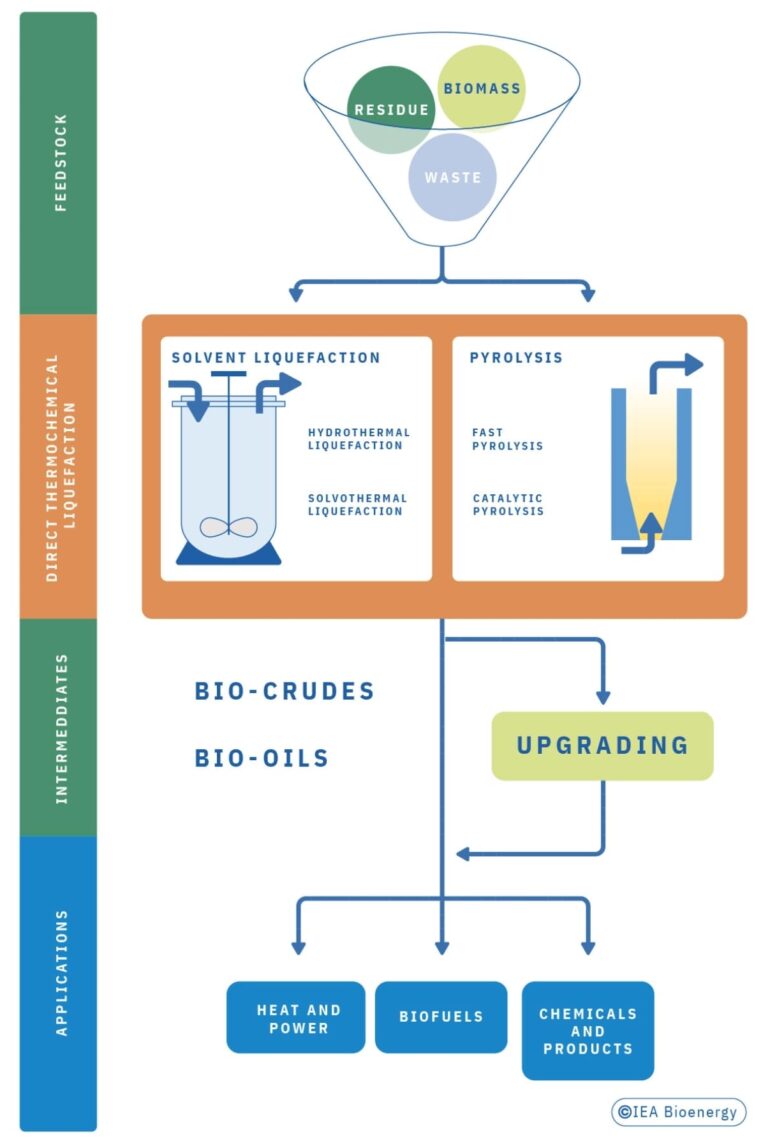
Hydrothermal liquefaction (HTL) was already attracting attention in the 1970s and 1980s. A wide range of raw materials can be processed using HTL, as no pre-drying of the feedstock is necessary. During the process, the pressure is maintained above water vapour pressure. The water thus remains liquid, acting as both solvent and primary reaction medium. The hydrolytic degradations that occur are much more efficient at lower process temperatures than dry thermochemical conversion technologies. Due to optimised process conditions, solids can be minimised, and the main part of the product is the desired bio-crude.
The product of solvent liquefaction is commonly known as bio-crude. In contrast to bio-oil, which is produced from fast pyrolysis, bio-crude usually has a lower content of oxygen and water. Bio- crudes are very different from petroleum oil and bio-oils. For example, bio-crudes are thermally more stable, exhibit higher viscosities, and have lower densities than bio-oils. However, bio- crude is not readily miscible with petroleum.
Pyrolysis is the thermochemical decomposition of solid biomass performed at elevated temperatures in the absence of oxygen. Thus, a solid, a liquid, and a gas fraction are achieved. The three product fractions are typically referred to as charcoal (or char or biochar), bio-oil, and product (or synthesis) gas. The distribution between the three products mainly depends on the pyrolysis process parameters, such as operating temperature and residence time in the reactor. Different modes of pyrolysis are also distinguished: fast, intermediate, and slow (depending on the process used—either torrefaction or carbonisation).
In fast pyrolysis, organic substances are heated within a few seconds up to 450–600°C in the absence of oxygen. Thus, the production of organic vapours is optimised at the expense of non- condensable gases (NCG) and char. The fraction of organic vapours is condensed into a liquid, the Fast Pyrolysis Bio-Oil (FPBO). Fast pyrolysis typically converts 50–75% of the weight of dry biomass into FPBO. Both of the other product fractions, char and NCGs, are used to generate heat and power for internal and external use, but the char can also be used to increase the level of carbon in soils and thus create negative greenhouse gas (GHG) emissions. The clean, mostly wood-based FPBO is used commercially to replace fossil heavy oils and natural gas in heat and power generation. FPBO typically contains up to 40% water and up to 5% solids.
Bio-oil or pyrolysis oil is a liquid biofuel produced by biomass pyrolysis. Bio-oil is a liquid emulsion of oxygenated organic compounds, polymers, and water. It contains acidic and reactive compounds which are thermally unstable. Bio-oil has a water content of 20–30% and an oxygen content of up to 40%. Consequently, bio-oil is different from bio-crude produced by solvent liquefaction. It also has properties that are dissimilar to those of petroleum oil and it is not miscible with petroleum. International standards are in place to regulate bio-oil quality for use
as boiler fuel.
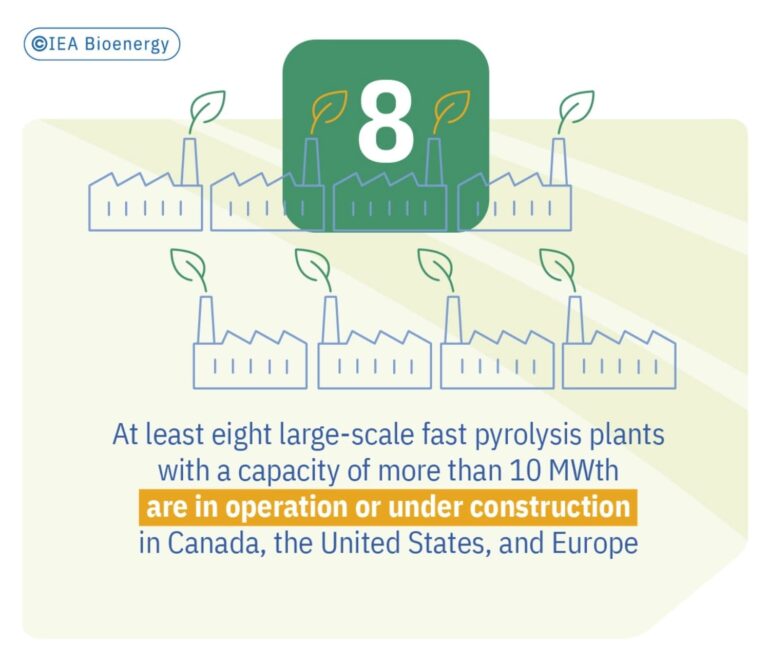
Technology readiness level and status of implementation
A study of commercial and demonstration scale thermal liquefaction plants in 11 countries that are active in the field, reveals that, to date, only fast pyrolysis plants are at demo- to commercial- scale (i.e., TRL 8–9). In contrast, hydrothermal liquefaction plants are at smaller (demonstration) scale. Wood and forest residues are the most used feedstock in commercial applications. Most of the bio-oils and bio-crudes produced are used as renewable heating oil and renewable fuel oil, respectively.

Hydrothermal liquefaction (HTL) technologies are now scaling up from pilot- to demonstration- scale. It is worth emphasising that the use of different feedstocks, like agricultural and urban waste and sewage sludge, as well as non-bio feedstocks, like waste plastics and waste tires, is increasingly being investigated or put into practice.
According to experts of IEA Bioenergy Task 34, the direct thermochemical liquefaction technologies are making important advances with respect to bioenergy deployment. An extension of production through additional fast pyrolysis units has recently been observed. With more and more pilot projects reaching a technological readiness level beyond 6 and with reducing cost levels, diverse demonstration plants can be expected in the near future. Future policy support could increasingly drive the number of commercial DTL plants for the bioenergy sector.
One very good example is a demonstration of FPBO co-processing in an existing fossil refinery which is being enabled by increased carbon prices. The Pyrocell fast pyrolysis unit has been in operation since 2021, and its product is currently being co-refined in the fluidised catalytic cracking (FCC) unit of Preem refinery in Sweden. This is allowing FPBO to be upgraded in an economic manner to increase the share of renewable carbon in traditional transportation fuels.
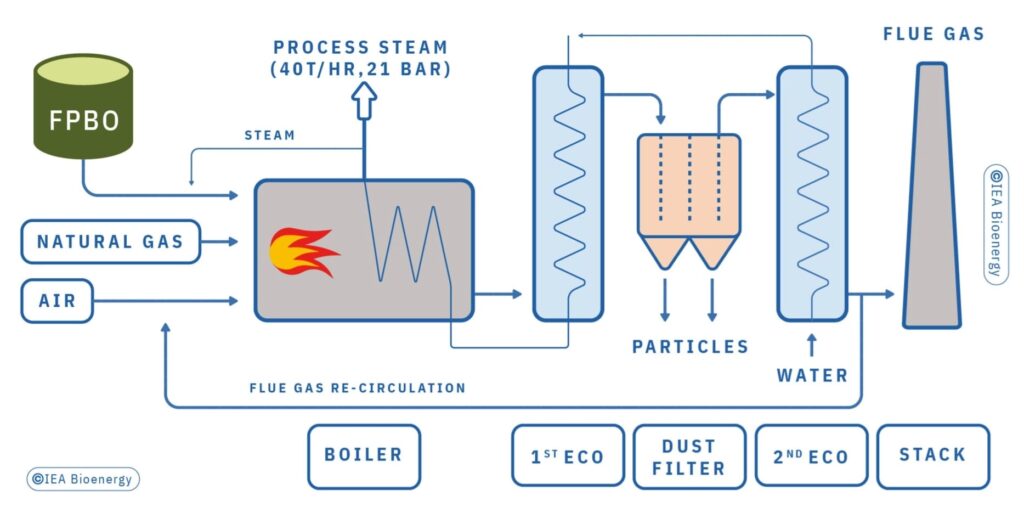
Environmental effects
Direct thermochemical liquefaction plants based on biomass and biomass-based wastes and residues have great potential in terms of GHG reduction when they are substituted for fossil fuel-based production. A recent study by IEA Bioenergy highlights the application of FPBO as a heating oil for steam production in industry. This evaluation indicated a 96% reduction of GHG emissions compared to using fossil fuels.
Moreover, the reutilisation of waste and residues in direct thermochemical liquefaction applications for the creation of new valuable chemicals, materials, or products enables circular economy-based production, thereby saving on other non-regenerative resources.
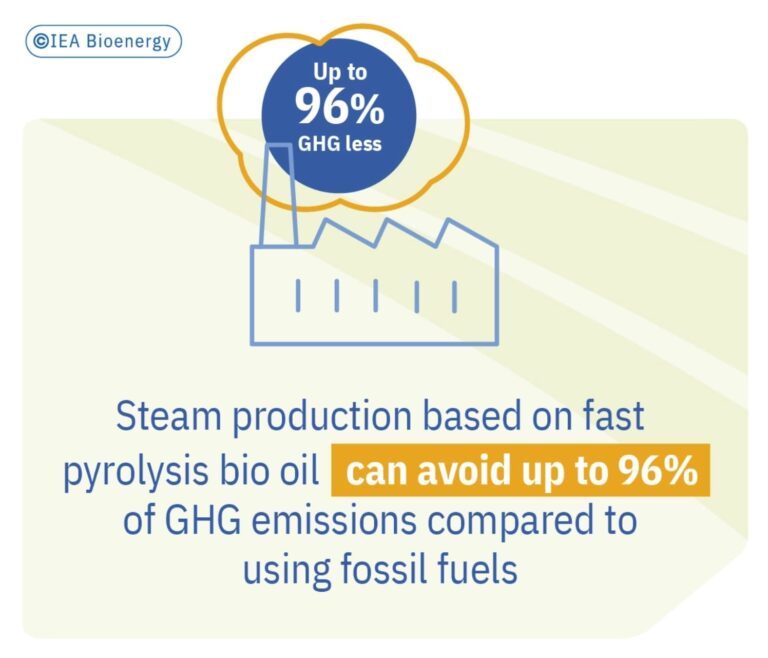
Costs
Only few cost estimates are available for the production of a transportation fuel by DTL technologies, for which additional upgrading steps (primarily hydroprocessing) are required. Moreover, different DTL technologies are at different technology readiness levels, which makes comparison difficult. The National Renewable Energy Laboratory of the U.S. Department of Energy assessed the thermochemical research pathways of fast pyrolysis vapours for the production of transportation fuels and evaluated some process economic aspects as follows.
The capital costs for a fast pyrolysis plant with integrated upgrading to produce, for example, transportation fuels, mainly depend on the design and size of the plant. Individual installations include the following:
- Feedstock & Handling;
- Pyrolysis & Vapour Upgrading;
- Pyrolysis Vapour Quench;
- Hydroprocessing & Separation;
- Hydrogen Plant;
- Steam & Power;
- Cooling Water & Utilities;
- Water management.
Costs for each of these items include capital recovery charge, net electricity, and fixed costs, as well as expenses for raw materials, catalysts, and waste treatment. However, these individual costs can vary enormously.
To keep production costs as low as possible, it is essential to take into account the feedstock being used and the targeted applications of the products and by-products when planning the plant design and business case. The cost-intensive pre-drying of raw materials can be cited here as an example. At best, costs can be considerably reduced through a suitable choice of feedstock. By-products such as the resulting process heat should also be used to increase economic efficiency. Consideration should also be given during the planning stage to the location of a direct thermochemical liquefaction plant, as this will influence the downstream transport costs of feedstock and products.
Current research gaps and opportunities
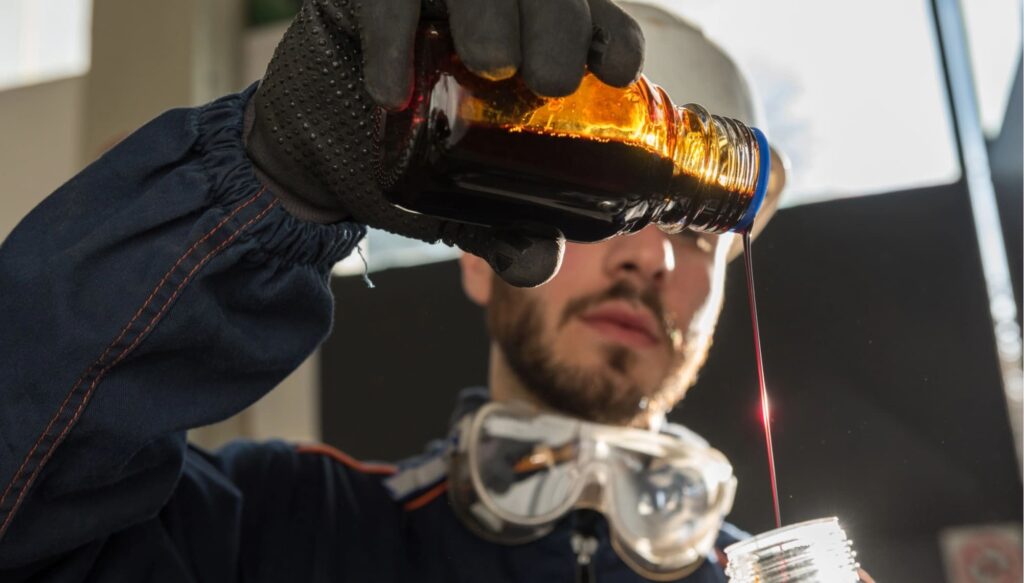
Experts of IEA Bioenergy Task 34 have shown that direct thermochemical liquefaction technologies have matured and that they are driving bioenergy commercialisation forwards. Commercial fast pyrolysis units and additional pilot plants for other DTL technologies have been successfully operated, which has led to a technology readiness level of 6–9. Given the variety of technology readiness levels, different aims can be stated for the immediate future. Regarding fast pyrolysis, overall production capacities need to be extended and value-added uses of the bio-oil commercialised. The main aim for other DTL technologies, such as hydrothermal liquefaction, is their scalability to industrial capacities at reasonable costs.
However, to gain entry to the energy markets, the commercialisation of several technologies still faces economic and other non-technical barriers. There are a growing number of companies and technologies working towards, or that have already realised, commercial applications. Even though an increasing number of plants are under development and in operation, in terms of improving technologies, the following are needed:
- Long-term operation of large-scale reactor systems for emerging processes;
- Operation in real environments for more developed processes;
- Demonstration of actual production costs for transportation fuels;
- Establishment of a minimum product quality for value added bio-oil/bio-crude applications with norms and standards for producers and users;
- Continuation of refining measures for safe handling, transport, and use;
- Supporting pioneer applications and identification of innovative niche markets for biofuels and bio-oils; and
- Dissemination of information
- Uncertainty of long-term cost estimates;
- Raw material supply and availability for planning purposes;
- Defining minimum product quality for value added bio-oil/bio-crude applications, and development of norms and standards for producers and users. These standards are needed for DTL products before they can gain a foothold in the market. Thus, various test methods, already developed, have been validated in round robin tests by the IEA Bioenergy Pyrolysis Network.
- Fast pyrolysis bio-oil is registered as a Registration, Evaluation, and Authorization of Chemicals (REACH) product in Europe. Accurate data on the bio-oil composition are needed to comply with this registration. The test methods being developed are thus essential to assess the qualitative and quantitative chemical composition of bio-oils, and also to monitor them during this early stage of market introduction.
- Rational insertion points for bio-oil and bio-crude in the (not fully compatible) hydrocarbon economy;
- Economic challenges to increase product value and flexibility; and
- Material incompatibility with the existing fuel handling system
Direct thermochemical liquefaction technologies provide several opportunities. Through this, a wide variety of residues and waste, in addition to biomass, can be processed, and valuable products developed. Depending on what wastes are used in the direct thermochemical liquefaction process, the bio-oils, bio-crudes, and also the char obtained from processing can be further processed into valuable products. Thus, these technologies can make a considerable contribution to establishing a circular economy and preserving resources.
In addition to large centralised plants, smaller decentralised plants are currently the preferred choice for processing residual and waste materials in order to shorten feedstock transport distances.
Powerful policy instruments
Stable policy support and long-term commitment are of the utmost importance for the introduction of new value chains. Direct access to R&D facilities is also highly desired. Currently, there are no policy instruments in place that directly and specifically support direct thermal liquefaction technologies. DTL technologies and their products do, however, benefit from general incentives such as a carbon tax/price, due to their high potential for reducing GHG emissions. Moreover, quota or direct support of applications such as regulations including second-generation biofuels in the transport sector lead to a relatively stable environment to further develop DTL technologies and value-added applications of its products.

The construction of the Empyro pyrolysis oil production plant in the Netherlands is a successful example of a commercial plant. At the time of Empyro’s development, a new incentive system was established through the Dutch SDE+ scheme which aims to encourage sustainable energy production. This incentive system provided financial support to produce renewable heat for 12 years.
- IEA Bioenergy Task 34 LINK accessed 18/02/2022
- IEA Bioenergy Task 34 LINK accessed 18/02/2022
- IEA Bioenergy Task 34 LINK accessed 18/02/2022
- IEA Bioenergy Task 34 (2020) Commercial status of direct thermochemical liquefaction technologies LINK accessed 18/02/2022
- IEA Bioenergy Task 34 LINK accessed 18/02/2022
- IEA Bioenergy Task 34 LINK accessed 18/02/2022
- IEA Bioenergy (2020) Bioenergy for High Temperature Heat in Industry – Case Study 3: Process steam in a dairy factory via fast pyrolysis bio-oil LINK accessed 18/02/2022
- IEA Bioenergy Task 34 (2021) Polar and non-polar components in Fast Pyrolysis Bio-Oil in relation to REACH registration LINK accessed 18/02/2022
- IEA Bioenergy Task 34 LINK accessed 18/02/2022
- IEA Bioenergy Task 34 (2021) Biobased gasoline from sawdust via pyrolysis oil and refinery upgrading LINK accessed 22/06/2022
- NREL National Renewable Energy Laboratory (2015) Process Design and Economics for the Conversion of Lignocellulosic Biomass to Hydrocarbon Fuels Thermochemical Research Pathways with In Situ and Ex Situ Upgrading of Fast Pyrolysis Vapors LINK accessed 18/02/2022
- IEA Bioenergy (2020) Bioenergy for High Temperature Heat in Industry – Case Study 3: Process steam in a dairy factory via fast pyrolysis bio-oil LINK accessed 18/02/2022
- IEA Bioenergy Task 34 LINK accessed 18/02/2022
- IEA Bioenergy Task 34: Round Robin archive LINK accessed 18/02/2022
- IEA Bioenergy Task 34 (2021) Polar and non-polar components in Fast Pyrolysis Bio-Oil in relation to REACH registration LINK
- IEA Bioenergy (2020) Bioenergy for High Temperature Heat in Industry Case Study 3: Process steam in a dairy factory via fast pyrolysis bio-oil LINK accessed 18/02/2022
